Bologna, Italy
By Jessica – January 24th, 2009
Like so many fascinating cities, Bologna is a study in contrasts: a center of radical politics in one of Italy’s wealthiest regions, a city of glittering shops and graffiti, brilliant terra-cotta buildings crowded along dark alleyways, and a huge basilica half clad in ostentatious Renaissance marble, half with its rugged underlying brickwork laid bare.
Bologna doesn’t have the art galleries of Florence, the canals of Venice, or the ancient landmarks of Rome, but it does have miles of stunning arcades and striking medieval architecture, one of the oldest universities in the world, and such a lack of tourists—in the colder months, anyway—that it’s often easy to believe you’re the first outsider to discover this marvelous place.
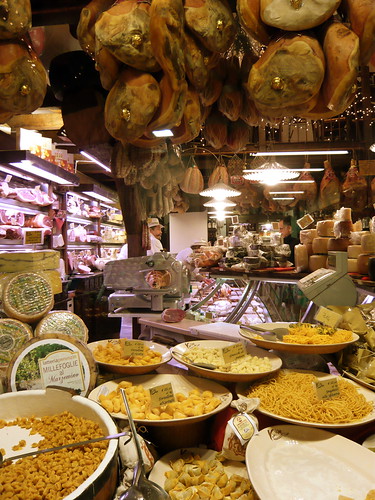 And the food...dear God, the food. Bologna claims to be Italy’s culinary capital, and I’m not one to argue. The list of foods originating in Bologna and the surrounding area—lasagna, tortellini, “spaghetti bolognese”, Parma ham, balsamic vinegar, parmesan cheese—reads like a what’s what of Italian cuisine. Then there’s “bologna” itself (or rather, the gargantuan but delicately flavored mortadella), along with pretty much any other cured pork products you can imagine.
And the food...dear God, the food. Bologna claims to be Italy’s culinary capital, and I’m not one to argue. The list of foods originating in Bologna and the surrounding area—lasagna, tortellini, “spaghetti bolognese”, Parma ham, balsamic vinegar, parmesan cheese—reads like a what’s what of Italian cuisine. Then there’s “bologna” itself (or rather, the gargantuan but delicately flavored mortadella), along with pretty much any other cured pork products you can imagine.
The food in the Emilia-Romagna region is less about tomatoes and olive oil and more about butter and cream, which makes it a great place to visit in the cold weather; there’s nothing better than sitting down to a mountain of eggy golden pasta swathed in cheese when it’s foggy and freezing outside. Fall and winter also bring chestnuts, mushrooms, truffles and game—all perfectly accompanied by a bottle of deep purple Sangiovese di Romagna.
Jeremy and I have been to Bologna twice, once as a sort of delayed honeymoon in November 2003, once for our ninth wedding anniversary in January 2009, both times as gastronomic explorers determined to consume as much regional cuisine as possible in a very short period of time (i.e., a long weekend). The first time around, we went without much advance planning—just a little guidebook and the conviction that we’d stumble across great restaurants without really trying. For the most part, that turned out to be true, though we didn’t manage to get into one restaurant we really wanted to try (Da Gianni) because it was all booked up, we barely managed to squeeze into another one (Trattoria Anna Maria) thanks only to the hospitality of the head waiter, and getting into a third one (Trattoria Meloncello) was a surreal adventure involving bouncers, football managers and carabinieri.
The second time around, I wanted to be a bit more prepared, so I scoured the web to find out where Bologna’s foodies were eating these days. As it turned out, most of the same names kept coming up: Da Gianni, Anna Maria, Meloncello. Remembering the near misses of the last trip, it seemed prudent to make reservations, so after much debate and consideration, we decided to try Da Gianni again on our first night and the highly praised Caminetto d’Oro on our second.
Da Gianni thwarted us a second time; it was still closed for the holidays, so we found ourselves instead being drawn back to Trattoria Anna Maria and the memory of its fabulous homemade pasta and crispy roasted meats.
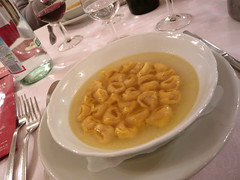 Our memories, I’m happy to say, did not betray us. We started off by sharing two classic Bolognese pasta dishes: tortellini in brodo, or tortellini in broth, and tagliatelle al ragí¹, the famed tagliatelle (not spaghetti!) in meat sauce. If there’s anything more pleasing than stepping into a cozy trattoria on a cold night and being presented with a steaming bowl of tortellini bathed in a rich golden soup, I’m sure I can’t imagine what it is—particularly when each tiny handmade pasta packet encloses such a flavorful filling of mortadella, prosciutto and parmesan. The tagliatelle al ragí¹ was no less revelatory, the meat sauce lightly mixed with pasta rolled so thin it was nearly translucent.
Our memories, I’m happy to say, did not betray us. We started off by sharing two classic Bolognese pasta dishes: tortellini in brodo, or tortellini in broth, and tagliatelle al ragí¹, the famed tagliatelle (not spaghetti!) in meat sauce. If there’s anything more pleasing than stepping into a cozy trattoria on a cold night and being presented with a steaming bowl of tortellini bathed in a rich golden soup, I’m sure I can’t imagine what it is—particularly when each tiny handmade pasta packet encloses such a flavorful filling of mortadella, prosciutto and parmesan. The tagliatelle al ragí¹ was no less revelatory, the meat sauce lightly mixed with pasta rolled so thin it was nearly translucent.
After the pasta, we moved on to the meat course: roasted guinea fowl for Jeremy and roasted pork shank for me, both of which were tender, tasty, and covered with crispy, salty pancetta (which is always a good thing). Not knowing what they were, I succumbed to curiosity and ordered a side dish of cardoons as well. When they arrived, I realized I had seen them at some vegetable stalls earlier: they look like oversized celery, taste a bit like artichokes, and were very lovely braised in a meaty broth in Anna Maria’s. And after all the pasta, meat and cardoons, we just had room to share a luminous zuppa inglese for dessert before rolling back out into the frosty night.
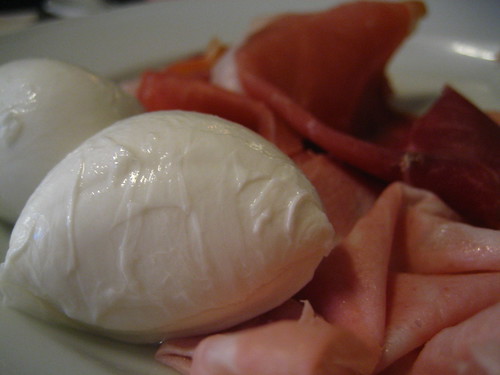 Another day, another opportunity to gorge ourselves. After a pastry and a super-creamy cappuccino at the Caffé Opera e Tulipani, which overlooks one of the only medieval canals still visible in Bologna, we strolled around on the frigid but beautifully sunny day to take pictures and work up a good appetite for lunch. Lunchtime found us at the quirky Drogheria della Rosa, where we were seated and promptly presented with two glasses of Prosecco and a scrumptious platter of salumi and fresh mozzarella. We splashed out and ordered a plate of mixed cheeses as well, which turned out to be a selection of hard cheeses like parmesan and pecorino.
Another day, another opportunity to gorge ourselves. After a pastry and a super-creamy cappuccino at the Caffé Opera e Tulipani, which overlooks one of the only medieval canals still visible in Bologna, we strolled around on the frigid but beautifully sunny day to take pictures and work up a good appetite for lunch. Lunchtime found us at the quirky Drogheria della Rosa, where we were seated and promptly presented with two glasses of Prosecco and a scrumptious platter of salumi and fresh mozzarella. We splashed out and ordered a plate of mixed cheeses as well, which turned out to be a selection of hard cheeses like parmesan and pecorino.
I wish I had known what each of the cheeses were, but not speaking Italian put us at a disadvantage—in more ways than one, it seemed, since we were just given small (Italian) menus to order from, while the other customers (all of whom were Italian and most of whom seemed to be regulars) were being served things that weren’t on the menu. It was the only time on either of my trips to Bologna that I really felt like a tourist; we were clearly not “in the know”, and it left me feeling a tiny bit uncomfortable.
 Having said that, almost every review I’ve read of Drogheria della Rosa has mentioned the warm hospitality of the outgoing proprietor, so maybe it was an off day or maybe I was misreading the situation. Anyway, it’s not like we were dissatisfied with the meal we got. My first course of oozy cheese tortelloni with tangy artichokes was outstanding, and Jeremy’s tagliatelle al ragí¹, while not reaching the sublime heights of Anna Maria’s, was rustically toothsome. Truth be told, I was already full after the pasta, but I gamely plowed through a massive filet steak, cooked to rosy red perfection, glazed with a glossy balsamic reduction and accompanied by delectably bitter endive and radicchio.
Having said that, almost every review I’ve read of Drogheria della Rosa has mentioned the warm hospitality of the outgoing proprietor, so maybe it was an off day or maybe I was misreading the situation. Anyway, it’s not like we were dissatisfied with the meal we got. My first course of oozy cheese tortelloni with tangy artichokes was outstanding, and Jeremy’s tagliatelle al ragí¹, while not reaching the sublime heights of Anna Maria’s, was rustically toothsome. Truth be told, I was already full after the pasta, but I gamely plowed through a massive filet steak, cooked to rosy red perfection, glazed with a glossy balsamic reduction and accompanied by delectably bitter endive and radicchio.
I learned an important lesson my first time in Bologna: if you attempt to eat an appetizer and a first course and a main course and a dessert at every single sitting, you will soon be incapable of doing anything but lying down and moaning. With that in mind, we skipped dessert at Drogheria della Rosa and did as much walking around as we possibly could before our reservation at Caminetto d’Oro that evening.
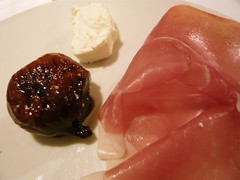 Though ostensibly a trattoria, Caminetto d’Oro feels more like an upscale restaurant, with its pristine white tablecloths and tasteful modern decor—and it’s got the prices to match. Again we were greeted with a glass of fizzy Prosecco, which was served alongside an amuse-bouche of tender, garlicky mortadella wrapped around a breadstick. Remembering the mind-blowing culatello with figs and parmesan mousse that I had at Papagallo restaurant on our first trip to Bologna, I chose an appetizer of Culaccia ham with sticky fig and fresh cheese—a combination made in heaven—while Jeremy opted for a roughly-chopped steak tartare topped with shavings of black truffle and seasoned at the table with olive oil, salt, pepper and celery seeds.
Though ostensibly a trattoria, Caminetto d’Oro feels more like an upscale restaurant, with its pristine white tablecloths and tasteful modern decor—and it’s got the prices to match. Again we were greeted with a glass of fizzy Prosecco, which was served alongside an amuse-bouche of tender, garlicky mortadella wrapped around a breadstick. Remembering the mind-blowing culatello with figs and parmesan mousse that I had at Papagallo restaurant on our first trip to Bologna, I chose an appetizer of Culaccia ham with sticky fig and fresh cheese—a combination made in heaven—while Jeremy opted for a roughly-chopped steak tartare topped with shavings of black truffle and seasoned at the table with olive oil, salt, pepper and celery seeds.
Pasta with squash is a popular winter combination in Italy, and I indulged my craving for it with a plate of handmade spinach lasagnette tossed with tiny cubes of pumpkin and topped with sweet, crunchy amaretti biscuits and parmesan cheese. And if Jeremy’s tortellini in brodo wasn’t quite as flavor-packed as Anna Maria’s, it was still warming and tasty and served, most pleasingly, with a big golden spoon.
After the pasta, it was time for more meat—and, in Jeremy’s case, yet more truffle, this time atop a massive meatball (or perhaps a very tiny meatloaf), a polpette so dense and rich that Jeremy couldn’t even finish it. I opted for the baked guinea fowl in a balsamic glaze, which was cooked beautifully and presented with a scrumptious artichoke soufflé; despite all the ham and pasta that preceded it, I wiped my plate clean. We even managed dessert afterwards: Though not generally a huge fan of ice cream, my little dish of artisanal iced milk and fat, sweet-tart cherries hit all the right notes, and Jeremy’s panna cotta with seasonal chestnuts was lusciously creamy. And the post-dessert espressi and biscotti were lovely too.
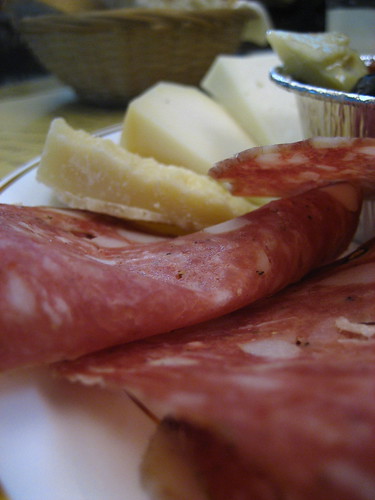 That wasn’t quite our last meal in Bologna; we just had time on Sunday to grab lunch at La Vecchia Malga, a delicatessen with three branches around the city and even one at the airport. We sat at a rustic wooden table upstairs from the shop and feasted on big plates of mixed cold cuts, cheese and marinated vegetables (olives, artichokes, sundried tomatoes).
That wasn’t quite our last meal in Bologna; we just had time on Sunday to grab lunch at La Vecchia Malga, a delicatessen with three branches around the city and even one at the airport. We sat at a rustic wooden table upstairs from the shop and feasted on big plates of mixed cold cuts, cheese and marinated vegetables (olives, artichokes, sundried tomatoes).
As we ate surrounded by legs of prosciutto, hefty salamis, massive wheels of cheese and crates of Italian wine, I thought that, with all of its earthy abundance, Bologna is a city dear to my heart. It’s a city that goes about its business but takes the time to appreciate the finer things in life. It wears its history and affluence lightly, and it’s quietly confident of its culinary supremacy. It knows it’s got a lot going for it, but it doesn’t go out of its way to grab your attention—it waits for you to come to it. And when you lose yourself in the endless porticos and endless meals and the rhythm of day-to-day life there, the city opens up to you, and you think you might just never leave.
Trip notes:
Here are the restaurants we’ve eaten at in Bologna:
- Caffé Opera e Tulipani, Via Alessandrini 7, Tel. 051 245 122
- Caminetto d’Oro, Via de’Falegnami 4, Tel. 051 263 494
- Drogheria della Rosa, Via Cartoleria 10, Tel. 051 222 529
- La Vecchia Malga, Via Pescherie Vecchie 3a, Tel. 051 223 940
- Ristorante Papagallo, Piazza della Mercanzia 3, Tel. 051 232 807
- Trattoria Anna Maria, Via delle Belle Arti 17, Tel. 051 266 894
- Trattoria Meloncello, Via Saragozza 240, Tel. 051 614 3947
Added September 2012:
- Eataly, Via Degli Orefici 19, Tel. 051 952 820 (a multi-story shop with books and Italian food products as well as a deli, café and wine bar)
- Serghei, Via Piella 12, Tel. 051 233 533 (an outstanding, cozy traditional trattoria)
- Trattoria da Gianni, Via Clavature 18, Tel. 051 229 434 (hidden away down an alley, full of locals, you’ll probably have to book a table)
Added September 2014:
- Ristorante Da Fabio, Via del Cestello 2, Tel. 051 22 04 81 (a wonderfully friendly, comfortable restaurant with outstanding Bolognese food - no printed menu, you just choose from the selections of the day [and I’m still dreaming of a celery and parmesand salad I had here]. It’s fun to go with a small group so you can try lots of stuff. And save room for the endless desserts and grappa afterwards!)
- Osteria Broccaindosso, Via Broccaindosso 7a, Tel. 051 234 153 (authentic, casual spot to eat with excellent antipasti, delicious pasta, and - again - an endless selection of desserts)
- Ristorante Diana, Via Indipendenza 24, Tel. 051 231 302 (the ultimate old-school eatery with heavy silverwear and waiters in white jackets. Classic Bolognese dishes in a restaurant where the regulars have been coming for decades. Nice for lunch.)
- San Silvestro in Cantina, Piazza Minghetti 2, Tel. 051 0873486 (a cozy restaurant serving classic Bolognese fare in a very classy way. When the weather cooperates, you can sit outside on the lovely square. Reservations recommended—though we got lucky...)
- Mercato di Mezzo, Via Clavature 12, Tel. 051 228782 (your one-stop market hall for craft beer, pastries and other nibbles in the center of Bologna. This indoor food hall has a variety of food and drink stands, as well as places to sit and enjoy your purchases. Be warned: it can get crowded, especially at lunch)
- Osteria Il Rovescio, Via Pietralata, Tel. 051 523545 (we were taken to this tiny, authentic osteria by a friendly attendee at a conference Jeremy spoke at. It’s warm and homely, and the rustic food is tasty—on the rainy day we were there, the daily dishes included wholemeal tagliatelle with chanterelles and a gorgeous ricotta cheesecake. You can also order pizzas made in the associated pizzeria next door)
- Salumeria Simoni, Via Drapperie 5, Tel. 051 231880 (the perfect place to sit in the busy Quadrilatero and enjoy some early evening snacks and drinks. You can buy cheeses and meats to take away as well)
- Caffí¨ Zanarini, Piazza Galvani 1, Tel. 051 275 0041 (on the pricey side, but the coffee and abundant pastries are great, and you can sit inside or outside on the square, or just lean on the counter to knock back your espresso. They do aperitivos as well, of course)
- Caffí¨ Terzi, Via Oberdan 10, Tel. 051 0344819 (old-school cafe offering a variety of coffee beans and pastries for a mid-morning pick-me-up)
Added October 2016:
If, like me, you don’t speak Italian and quaver at the thought of trying to make restaurant reservations over the phone, try Yubuk, which lets you request reservations online for almost all of the restaurants I’ve mentioned (I used it to make the Caminetto d’Oro reservation).
For a taste of Bologna in your own home, check out the tagliatelle al ragí¹ recipe from Trattoria Anna Maria (there’s even a video!), or the lasagnette with pumpkin from Caminetto d’Oro (bizarrely, in German—I’ll try to post a translation here at some point).
On a past trip, we stayed at the Hotel Paradise, an unassuming but fantastically located hotel with very friendly staff—and free WiFi!
And just for the heck of it, here’s a nice article about Bologna in the San Francisco Chronicle from a few years ago. Clearly, we’re not the only ones to have fallen under Bologna’s spell...

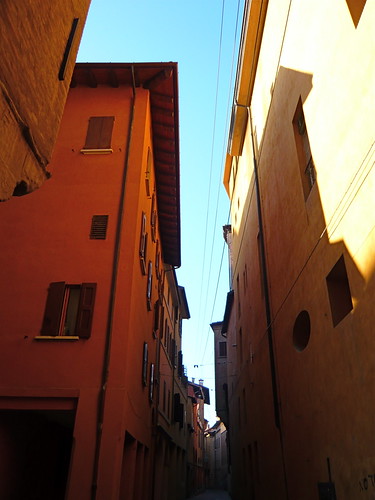
Comments
You don’t know how much you inspire me! I ran with the "tiny cubes of pumpkin" and made butternut squash for my pasta last night, and with all the other flavorings, it was more wonderful than anything I would have cooked on my own! I also converted your recipe for pizza "sauce" with fennel seeds into a pasta dish. Oh joy! Thank you!
I’m so happy to hear that - thank you, Indi!
Jessica
My friend is in Bologna on business today and planned to eat at her hotel (Sheraton) tonight. Have sent her a good telling off and sent this link and your suggestions with instructions to ‘Eat Well!’ Hope she takes advice! Excellent post and so very timely…
THANKS SO MUCH…
WE ARE LEAVING FOR BARCELONA TODAY. I WANTED TO FIND OUT ABOU THE FOOD IN BOLOGNA GOING THERE ON FRIDAY. I AM SO EXCITED AFTER READING YOUR ARTICLE. THE FOOD SOUNDS SO GOOD. I SENT THIS INFO TO ALL MY ITALIAN COUSINS.
CAN NOT WAIT. THANKS
mmmmm… food…
We went to Bologna in October, 2011. Our visit was somewhat accidental. We took a trip to Europe and wanted to visit Paris and Florence. The airline deal I got sent us home via Bologna. We decided to spend a day in Bologna just to see another city.
We found a food tour called Italian Food Days which was fantastic. A day learning about parmesan cheese, wine, balsamic vinegar and prosciutto followed by a fantastic meal of pasta, wild boar, rabbit and wine.
We were able to get two dinners in Bologna. Nothing in Paris or Florence compared to our meals in Bologna. Everyone we met in Florence spoke so fondly of the food in Bologna, but we were still taken back by the wonderful meals and fantastic gelato we found. I shopped at several small groceries while I was there.
And your comment about the lack of tourists was dead on. There were lots of people in Bologna - but they lived there.
I think this is a real jewel of a European city to visit. We plan to return.
Jessica, this article is just what we need. We are currently in Bologna and will be sure to check out some of your recommendations during the rest of our stay!
Bologna may not have as many canals as Venice, but it actually does have several, including one canal right in the heart of the historical center, though few people know it’s there. In the right season, there are guided tours on the water which goes underneath the city and pops up as part of Canale delle Moline.
http://www.bolognawelcome.com/en/places-to-see/suggested-itineraries/params/Percorso6/Luoghi356/ref/Canale%20delle%20Moline
The tiny window you can view the canal through is one of my favorite places in Bologna, which is my favorite city in Italy (aside from where I live, of course).
Thank you for your wonderful article! I am from Bologna and it warms my heart and makes me smile with pride to read how much you enjoyed my hometown. I now live in Canada, but both my parents and all my family are still in Bologna. Every time I can go back my mouth waters at the thought of what I will eat once there!
I loved to read the post about Bologna, I cannot thank you enough to have shared our food traditions with the other readers. Fantastic post and very good pictures, Thanks!
Sorry. Comments are closed.